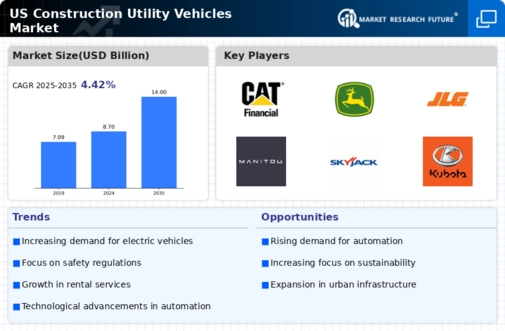Increasing Infrastructure Investments
the construction utility-vehicles market is expected to grow due to escalating investments in infrastructure across the United States.. Government initiatives, such as the Infrastructure Investment and Jobs Act, have allocated substantial funding for roads, bridges, and public transit systems. This influx of capital is likely to stimulate demand for construction utility vehicles, as contractors require efficient and reliable equipment to meet project deadlines. In 2025, the market is projected to expand by approximately 8%, driven by these infrastructure projects. As urbanization continues to rise, the need for construction utility vehicles that can navigate diverse terrains and perform various tasks becomes increasingly critical, further propelling market growth.
Labor Shortages and Automation Trends
The construction utility-vehicles market is significantly influenced by ongoing labor shortages in the industry. As skilled labor becomes increasingly scarce, construction companies are turning to automation and advanced machinery to maintain productivity. This trend is likely to drive demand for construction utility vehicles equipped with automated features, such as self-driving capabilities and remote operation. In 2025, the market is expected to expand by approximately 6% as firms invest in technology that compensates for labor shortages. The integration of automation in construction utility vehicles not only enhances efficiency but also addresses the challenges posed by a diminishing workforce.
Rising Demand for Versatile Equipment
The construction utility-vehicles market is experiencing a surge in demand for versatile equipment capable of performing multiple functions. Contractors are increasingly favoring vehicles that can adapt to various tasks, such as lifting, towing, and transporting materials. This trend is driven by the need for efficiency and cost-effectiveness in construction projects. In 2025, the market is anticipated to grow by 6% as businesses recognize the value of investing in multifunctional vehicles that can reduce the need for multiple specialized machines. The ability to switch attachments and tools enhances productivity on job sites, making versatile construction utility vehicles a preferred choice among contractors.
Technological Advancements in Vehicle Design
Innovations in vehicle design are significantly impacting the construction utility-vehicles market. Manufacturers are increasingly integrating advanced technologies, such as telematics and automation, into their vehicles. These enhancements not only improve operational efficiency but also reduce fuel consumption and emissions. For instance, the introduction of telematics systems allows fleet managers to monitor vehicle performance in real-time, leading to better maintenance and reduced downtime. As a result, the market is expected to witness a growth rate of around 7% in the coming years, as companies seek to modernize their fleets with cutting-edge construction utility vehicles that offer improved functionality and sustainability.
Focus on Sustainability and Environmental Regulations
the construction utility-vehicles market is shaped by a growing emphasis on sustainability and compliance with environmental regulations.. As the U.S. government implements stricter emissions standards, manufacturers are compelled to develop eco-friendly vehicles. This shift towards sustainable practices is likely to drive innovation in electric and hybrid utility vehicles, which are becoming increasingly popular among construction firms. By 2025, the market is projected to grow by 5% as companies seek to align with environmental goals and reduce their carbon footprint. The adoption of greener construction utility vehicles not only meets regulatory requirements but also appeals to environmentally conscious clients.
























Leave a Comment